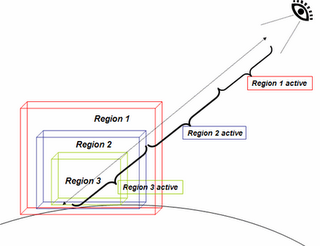
Tony from Khronos.org wrote in with some details about 3D modelling for Google Earth in reply to a recent post about texture support. I don't know much about this stuff but I thought it was interesting, so here's his letter almost verbatim.
"By using COLLADA as their format for geometry and textures, Google has suddenly offered a mainstream 3D visualization environment and 3D world to anyone in the 3D modeling, AEC, and game model development communities."
"I saw your post on MIT Advertising Lab about Google Earth now supporting textures, and I thought you might be interested adding more details - something that was pretty significant but seems to have been missed by most of the press
Google Earth and KML 2.1 now use the COLLADA interchange format for 3D geometry and textures
COLLADA is an open standard for that defines an XML-based schema for 3D authoring applications to freely exchange digital assets without loss of information.
If you check out the textured 3D sample file in [Google's] KML 2.1tutorials you will see that they include both the COLLADA .dae file and the textures in a compressed zip file. They add the geospecific data in their own xml file.
Collada is a way to enable full interoperability between 3D applications - you can move content freely from one application, add something else in (like shaders or physics), and then pass the model on to the next in a tool chain sequence.
This is significant because (in addition to giving Google Earth the capabilities for 3D textures) it means you can use any of the popular 3D modeling applications including Maya, SoftImage|XSI, 3ds Max, Blender, and Sketchup of course, to create sophisticated models with textures, export them as COLLADA, and then import or drag and drop them into Google Earth.
Combined with the new KML support for LOD and streaming, you have some pretty high performance 3D visualization, virtual reality and advertising capabilities. Suddenly Google Earth is opened up to the entire creative community.
What is also interesting is that game developers, who are very familiar with COLLADA can now start exporting their assets to Google Earth. (FYI Collada is the file format for the new PlayStation3) IMHO it does not seem far off when this will enable Google Earth to beome the new Second Life but with true geospatial capabilities.
At this point, Google Earth has not implemented support for animation, shaders or physics. But these are supported in the COLLADA format, so it is likely only a matter of time.
Suddenly, there is this venue where anyone who does 3D models will have a place where they can display these models. And it is a mass market commodity venue. There has never been anything like this. Google Earth is single handedly making 3D visualization on the web, become an everyday thing. And with Collada support, they are making it easy for everyone to participate and contribute content.
Sure you can use high end systems like Autodesk or Maya to display 3D renderings and scenes. But that is not mainstream and not anywhere as easy as Google Earth to use. There is room for both, but Google Earth is compelling to untrained (as well as highly trained) users. It makes viewing 3D models in context, easier and more engaging. Google Earth's 3D look and fell is almost like a video game - and that is a good thing for getting people involved!
So with Collada and Google Earth, you have interoperability between programs for 3D content and you have a mainstream way to engage people with the content."
